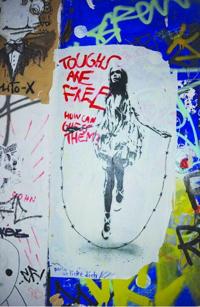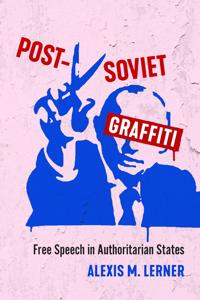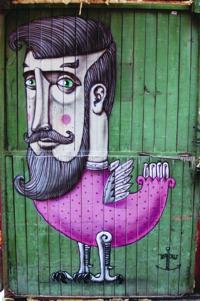Navy professor writes new book on protest in authoritarian regimes.

Alexis Lerner
Before I left for Ukraine to do fieldwork in 2011, my grandfather, Leibi, gave me a mission — “Go find my old house in Munkács,” he said. He was referring to the town in Hungary he left as a teen during the war, now known as Mukachevo in western Ukraine. He told me that before boarding the Kasztner Train, he had etched his name into the brick façade of his home.
I found it when I arrived — his name, still carved into the exterior wall. But I also found two Jewish stars alongside his name. It was a jarring contrast. From first person — I lived here; this was my home — to third person — a Jew lived here, and all the danger and erasure that might imply in 20th-century Hungary.
Every piece of graffiti tells a story. Sometimes the story is simple — who are your friends? Who do you love? But other times, and this is especially true in authoritarian states, graffiti can be used by citizens as a tool for self-expression, even when the social and political narrative is tightly controlled. The public sphere can therefore be a canvas for subversive messaging, including censored viewpoints, controversial political sentiment and social taboos. It can even be used to mobilize against the regime.

Holocaust survivor jumping rope with barbed wire was photographed by the author in Berlin, Germany, in December 2013.
I first became interested in the topic of how graffiti can be used to circumvent censorship in 2009, when I was living in Saint Petersburg, Russia. Every day, I walked the same route up Nevskii Prospekt to Saint Petersburg State University. Along my commute, I’d pass the time by reading the walls along my walk. They were covered with messages — critiques of Russia’s nuclear policy, stenciled portraits of jailed dissidents and jokes at the expense of politicians. This was political content that was not appearing in the mainstream media. I wanted to know if this was something unique about Russia, the post-Soviet region or even authoritarian states more generally.

Over the next 10 years — from 2009 to 2019 — I spent all my free time systematically exploring the back alleys and highway underpasses of the post-Soviet and post-Communist European regions. From Berlin in the west to Vladivostok in the east, I documented public art and graffiti, while also interviewing every artist, activist and academic that would talk with me.
During this decade, I learned that graffiti could be used to share information and political opinions that challenged the state, its policies and its dominant collective memory. Heads of state like Putin, Lukashenko and Orban were cartoonized and mocked.
Liberal-democratic states had political graffiti, too — in Latvia and the Czech Republic, for example, colorful murals called out politicians for corruption and gentrifying policies. And the region’s history of discrimination played a key role in countries like Poland, where calls of “Heil Hitler” cover the walls of Lodz, or Germany, where I once saw a stencil of a Holocaust survivor jumping rope with barbed wire. If the streets tell us the topics that really matter to everyday people, the slew of antisemitic content tells us something concerning.

Tsar Nicholas II on the body of a mythical creature was photographed by the author in Moscow, Russia, November 2016.
But it wasn’t just subversive artists and activists that saw the benefit of writing about politics on the walls of their city; states understood it, too. By the mid-2010s, four-story murals of national heroes and patriotic slogans began to cover cities like Moscow, Warsaw and Almaty. The murals were aesthetically pleasing, openly funded by the state, and had the effect of completely flooding out the free speech that had previously covered those downtown spaces.
Of course, critical voices still exist. But they have receded further into the shadows — into residential districts with messages shrouded by greater nuance in the name of plausible deniability. States like Russia are doubly successful at monopolizing the public narrative as many critical artists have left for Israel and the West since the war in Ukraine began in early 2022.
These topics and more make up my new book, Post-Soviet Graffiti: Free Speech in Authoritarian States (University of Toronto Press, 2025). This July, I’ll be back in my home state, speaking about my book and signing copies at the Isaac Agree Downtown Synagogue. The talk will touch on politics, art and collective memory. If you’re curious how graffiti can be used to chip away at the state — or why a brick wall in western Ukraine matters — I hope you’ll join me.
Dr. Alexis Lerner is an assistant professor of political science professor at the U.S. Naval Academy. She will be speaking about her new book Post-Soviet Graffiti: Free Speech in Authoritarian States at the Isaac Agree Downtown Synagogue on Tuesday, July 8, at 6:30 p.m. Learn more at postsovietgraffiti.com. The views expressed in this article are those of the author and do not reflect the Department of Defense, the Department of the Navy or the United States Naval Academy.





